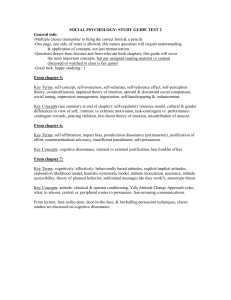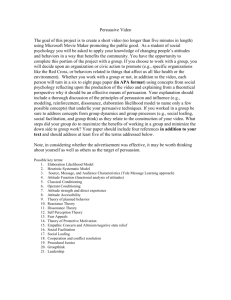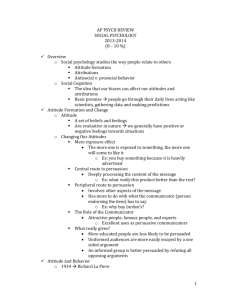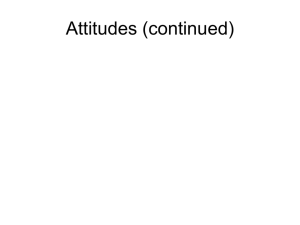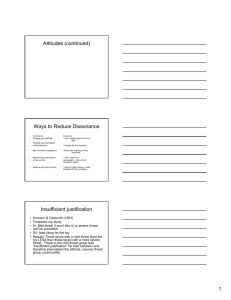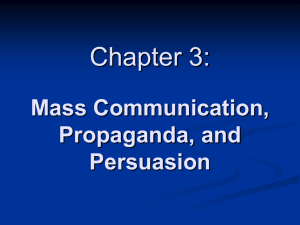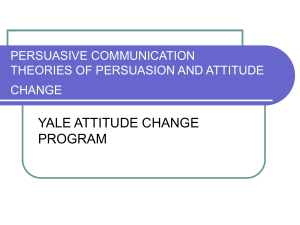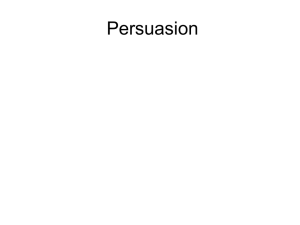Social Psychology
advertisement
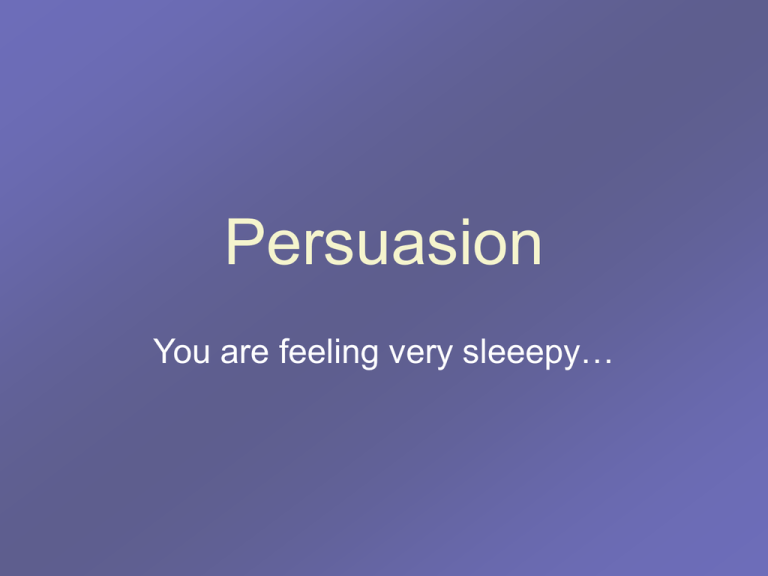
Persuasion You are feeling very sleeepy… Bumper Stickers - “I’ll give up my gun when they pry it from my cold, dead hands.” Billboards - “Get U.S. out of the U.N.” Magazine Ads - “Think different” Television Ads - “Where’s the beef?” Radio Ads - “This program is brought to you by Exxon, working for a better environment” T- shirts - “No Nukes” Lawn Placards - “Vote for Rosenberg” Mailings, etc. 300 to 400 appeals/day from marketers alone Outline • Attitudes – Theories of Attitude Change – Factors affecting attitude change • Persuasion – Dual-Process Model – Factors influencing persuasion Martin Luther King, Jr. National Rifle Association What are attitudes? • ABCs of attitudes – Affective: evaluations are based on positive and negative emotions associated with a target – Behavioral: a behavioral tendency to act in a certain manner towards the attitude object – Cognitive: evaluations based on beliefs & facts "Mmmmm... Gummi Beer." Homer Simpson’s Attitudes Toward Beer Affective Evaluation Beer Homer’s Attitude Toward Beer Behavior Regarding Beer Cognitions Regarding Beer "Oh Lisa, you and your stories: 'Bart is a vampire', 'Beer kills brain cells'. Now let's go back to that building... thingy... where our beds and TV... is." "The other day, I was so desperate for a beer, I snuck into the football stadium and ate the dirt under the bleachers." Consistency in persuasion 1. Balance theory (Heider, 1946, 1958) - we are motivated to have harmony in our views and behaviors - we want to agree with people we like a disagree with those we don’t Think of someone you respect / like. What if they expressed an opinion you opposed? 1. Could change your feelings for the person 2. Could change your opinion on the issue If you like Tiger, shouldn’t you like the car? Balance Theory Balanced Situations + Michelle Teacher + - Michelle + Teacher - Legalized abortion + Legalized abortion + - Michelle Teacher Michelle Teacher - - + - Legalized abortion Legalized abortion Balance Theory Imbalanced Situations - Michelle Teacher + + Michelle + Teacher - Legalized abortion + Legalized abortion + - Michelle Teacher Michelle Teacher + - - - Legalized abortion Legalized abortion Consistency in persuasion 2. Cognitive dissonance theory - we will work to resolve inconsistencies in our beliefs and actions when they matter to us - changing a behavior can change an attitude (and vice versa) Changes in attitudes occur primarily when we perceive justification – e.g., free will in determining our (inconsistent) actions Ready to turn some pegs?? • Students spent hour turning pegs in holes (really boring) • Paid either $1 or $20 • Who enjoyed the task more (when asked later)? • Why $1 people $20 was justification enough, $1 wasn’t – I must have really liked turning pegs! (Festinger & Carlsmith, 1959) Ratings of task enjoyment 25 20 15 10 5 0 No lie $20 lie $1 lie Insufficient justification Attitude change happens when one freely performs an attitude-discrepant act for an inadequate reward. Initiation Dissonance begins with: Amplification More dissonance arises when the action or decision: Motivation Reduction Dissonance is Dissonance is experienced as: reduced through: is seen as freely chosen. action or decision that conflicts w/ impt. aspect of self. Can’t be justified as due to strong reward or threat produces negative consequences that were foreseeable cannot be withdrawn unpleasant arousal. change designed to remove the unpleasant arousal. What affects how consistent we are? • Arousal – Tranquilizers cause people to not change their opinions • Preference for consistency • Consequences – More impact of your behavior = more likely you will be to change your attitudes • Salience of inconsistency Consistent with what? Individualist “me” focused Collectivist group focused Persuasion change in private attitude or belief as a result of receiving a message Dual Process Model - takes into account two ways attitude change takes place - e.g., central vs. peripheral processing, systematic vs. heuristic processing, etc. Certain information is processed more deeply than other info Persuasion Attempt Audience Factors Processing Approach Persuasion Outcome High motivation and ability to think about the message Deep processing, focused on the quality of the message arguments. Lasting change that resists fading and counterattack Low motivation or ability to think about the message Superficial processing, focused on surface features, e.g.: communicator’s attractiveness or number of arguments Temporary change that that is susceptible to fading and counterattack Message “Retirement planning can be a way to stay ahead of the game.” Cris Carter Schwab Investor Central or Peripheral? What affects level of processing? • Personal relevance • Need for cognition • Ability - amount of information, cognitive capacity, format of message (medium, who it’s given by, etc.) Who says... What... By what means... To whom? Channel Communicator • spoken • Credibility • written • expertise • audio • trustworthiness •Video • Attractiveness Message content Audience • Reason vs. emotion •Need for Cognition • Discrepancy • One vs. two-sided Who says? --- The communicator Communicator • Credibility • expertise •Credibility: believability • e.g., Hovland & Weiss (1951) • trustworthiness • Attractiveness • expertise: the amount of knowledge the source is assumed to have • trustworthiness: the perceived intention of the communicator to deceive. • e.g., Eagly and others (1978) •Perceived expertise • Begin by saying things the audience agrees with • Be introduced as someone knowledgeable on the topic • Speak confidently (no stuttering), and quickly Class Demonstration • Message on Phosphate containing detergents – Source • Government Agency • Soap Company Who says? --- The communicator • Attractiveness: having qualities that appeal to an audience • physical appeal • likeability • perceived similarity • surface characteristics (Dembroski and others, 1978) • attitudes & values • Persuasive on matters of subjective preference (e.g., aspirin, soft drinks) •Communicator characteristics less relevant when the subject matter is important to participants Petty and others (1981) Agreement with the message Strong argument 0.8 0.6 0.4 0.2 0 -0.2 -0.4 -0.6 -0.8 Low Low personal relevance High prestige of speaker Weak argument Low High High personal relevance The Sleeper Effect (Hovland & Weiss, 1951) % attitude change 25 20 Expert source 15 10 5 0 Nonexpert source Immediate Time interval Four weeks What is said? Message content • Reason vs. emotion • Discrepancy • One vs. two-sided 1. Is a carefully reasoned message more persuasive, or one that arouses emotion? 2. Will you be more persuasive by advocating an extreme point of view, or by advocating a moderate position? 3. Should your message be one-sided, or should it acknowledge two points of view? 1. Is a carefully reasoned message more persuasive, or one that arouses emotion? Reading with no food 90 Eating while reading 75 60 45 30 15 0 Cancer Cure Armed Forces Moon Trip 3-D Movies (Dabbs & Janis, 1965) 2. Extreme or moderate point of view? Discrepancy interacts with communicator credibility Agnes Stearns T.S. Eliot 5 4 Opinion change 3 2 1 0 Small Medium Large Discrepancy (Aronson et al., 1963) 3. One-sided or Two-sided? The interaction of initial opinion with one- versus two-sidedness Initially opposed Opinion change Initially agreed 60 50 40 30 20 10 0 One-sided Two-sided The message (Hovland et al., 1949) The Channel of Communication Message difficulty & transmission type (Chaiken & Eagly, 1978) Easy message Opinion change Difficult message 5 Channel 4 • spoken • written 3 • audio •Video 2 Written Audio Tape Video Tape Channel type (Chaiken & Eagly, 1978) Audience Effects: Need for Cognition Scale 1 = not at all like me 2 = somewhat unlike me Audience 3 = uncertain •Need for Cognition 4 = somewhat like me 5 = very much like me 1. I really enjoy a task that involves coming up with new solutions to problems 2. Thinking is not my idea of fun 3. The notion of thinking abstractly is appealing to me 4. I like tasks that require little thought once I've learned them 5. I usually end up deliberating about issues even when they do not affect me personally 6. It's enough for me that something gets the job done; I don't care how or why it works 7. I prefer my life to be filled with puzzles that I must solve 8. I only think as hard as I have to. Class Demonstration • Compute need for cognition score – Add up scores (reverse score 4 and 6) • Compute scores for essay evaluations – Add up scores • On a piece of paper indicate: – Need for cognition score: – Essay A: – Essay B: Positivity of message evaluation 7 6 5 4 3 2 1 0 Strong arguments Weak arguments Low NC High NC Need for cognition (Cacioppo et al., 1973)
